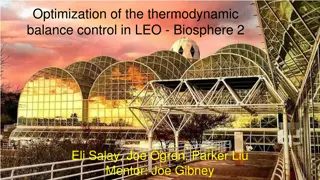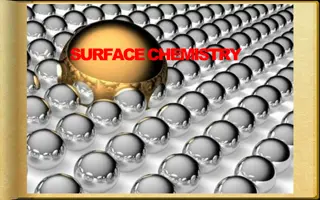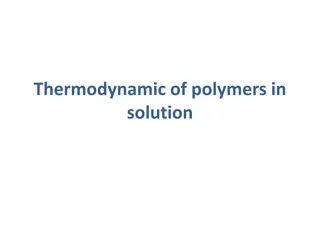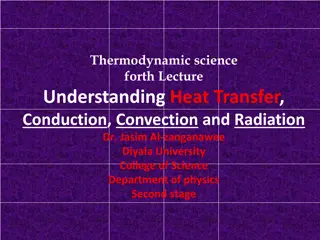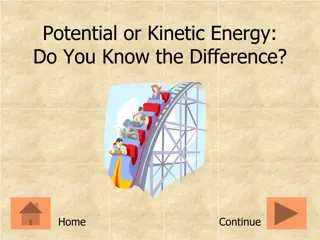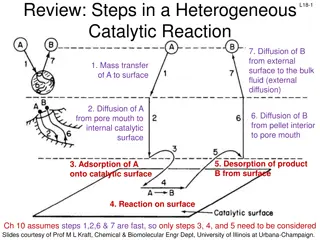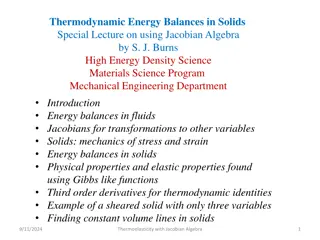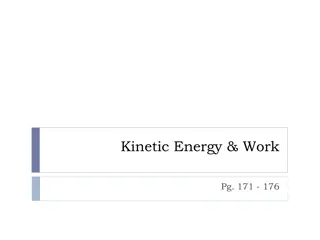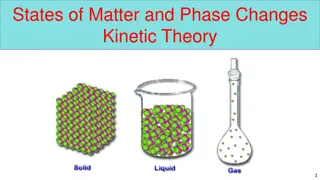Understanding Thermodynamic and Kinetic Characteristics in Adsorption Systems
Explore the thermodynamics and kinetics of adsorption through discussions on equilibrium thermodynamics, adsorption isotherms, kinetic measurements, technical applications, and interaction forces. Learn about the distinctions between physisorption and chemisorption, as well as the terminology associated with adsorption processes.
Download Presentation

Please find below an Image/Link to download the presentation.
The content on the website is provided AS IS for your information and personal use only. It may not be sold, licensed, or shared on other websites without obtaining consent from the author. Download presentation by click this link. If you encounter any issues during the download, it is possible that the publisher has removed the file from their server.
E N D
Presentation Transcript
Thermodynamic and kinetic characteristics Fyodor Fyodor Malchik Malchik
Thermodynamics and Kinetics of Adsorption subtitle: What can we learn about adsorption systems from thermodynamic and kinetic measurements? IMPRS-Lecture Series 2012: Experimental and Theoretical Methods in Surface Science Klaus Christmann Institut f r Chemie und Biochemie, Freie Universit t Berlin Organization 1. Introduction; terms and definitions 2. Thermodynamics of adsorption Adsorption as a macroscopic (thermodynamic) phenomenon Equilibrium thermodynamics and adsorption isotherms: Langmuir and BET isotherm The adsorption energy: Initial adsorption energy and a-priori heterogeneity Coverage dependence of the adsorption energy: lateral interactions and a-posteriori heterogeneity 3. Kinetics of adsorption and desorption The rate of adsorption; trapping and sticking The rate of desorption; order of desorption and frequency factor The desorption energy: Binding states and lateral interactions Experimental procedure and evaluation of TD spectra 4. Summary and conclusions
Technical applications of adsorption: Separation processes of gaseous and liquid mixtures via molecular sieves Heterogeneous catalysis Chemical analyses (various types of chromatography) Flotation processes Gas mask filters Lubrication phenomena Optical coatings corrosion-resistant coatings (Lotus effect) As we will see later, one distinguishes chemical adsorption (chemisorption) and physical adsorption (physisorption), depending of the strengths of the interaction between adsorbent and adsorptive. While chemisorption is most essential for heterogeneous surface reactions, physisorption plays a major role during separation and enrichment processes at and near phase boundaries.
1. Terminology: Strength of interaction forces - physisorption and chemisorption Kind of interaction Interaction forces responsible for adsorptive bonds Strength of interaction Very weak (usually less than 50 kJ/mole) van-der-Waals ionic Strong (Coulombic origin) > 100 kJ/mole covalent Strong (quantum- chemical origin) > 50 kJ/mole Strong (quantum- chemical origin), E > 50 kJ/mole metallic
Terminology: associative and dissociative adsorption The dissociation of a diatomic molecule can be better characterized by a two-dimensional potential energy representation. In these so-called elbow-plots the perpendicular distance of the molecule, y, is plotted against the internuclear distance, x. Whether or not the molecule can successfully dissociate depends on its translational and/or vibrational excitation. early barrier late barrier
Terminology: associative and dissociative adsorption The dissociation of molecular hydrogen has been studied theoretically in great detail, for example on Pd(100) surfaces by A. Gro et al.. Quite important is the so-called dynamical steering where the H2 molecule is guided to the optimum dissociation sites.
Terminology: activated and non- activated (spontaneous) adsorption In the adsorbed state and in thermal equilibrium the trapped particle resides at the bottom of the potential well. It is either physically or chemically adsorbed on the solid. In order to desorb it from the surface, one has to supply it thermally or electronically with the energy required to return to the gas phase. If activation barriers are involved, these have to be additionally overcome, and the desorbing particles then possess more energy than they had if they were in thermal equilibrium with the surface. activated adsorption: hydrogen on a Cu(111) surface Non activated (spontaneous) adsorption: CO on Ni(111)




